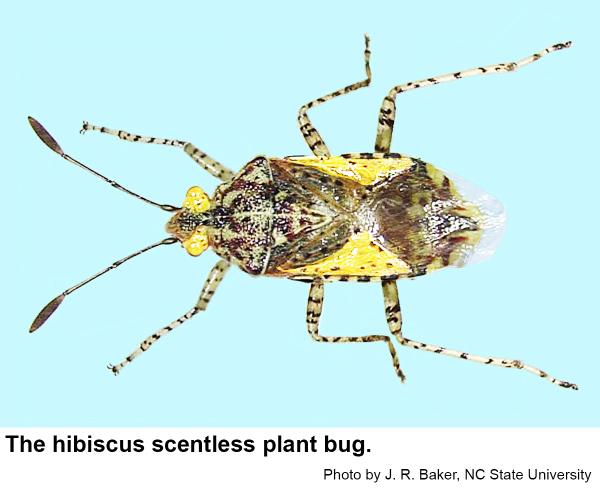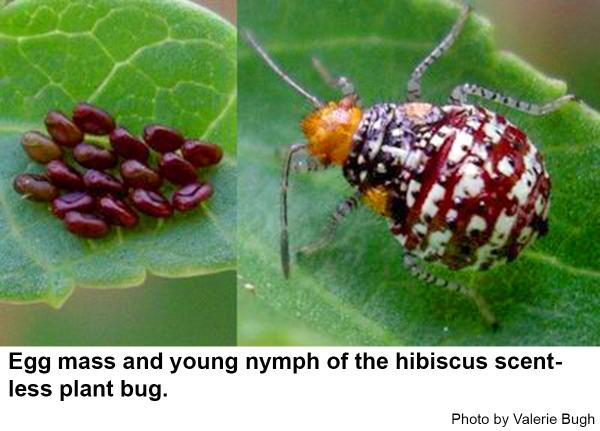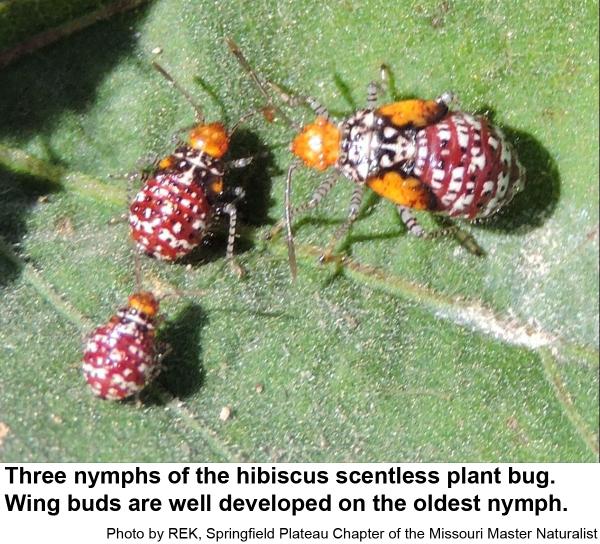Description and Biology
The hibiscus scentless plant bug, Niesthrea louisianica, is associated with rose-of-Sharon and hibiscus. This small bug is mostly white to gray with black markings on the body and legs. The head and outer margins of the wings are yellow to orange. Nymphs are smaller that adults, lack wings, and the abdomens tend to be purple with white markings. The eggs are dark reddish brown. It feeds on flower buds and seeds. Starting in late April and early May, eggs are laid in masses of one to 36 on the undersides of leaves. Each female can lay over 700 eggs. Newly hatched nymphs feed on developing flowers and on last year's seed pods. The first generation matures in June and lays its eggs on buds, flowers, and seed pods. We have at least three to four generations per year in North Carolina. By the end of the growing season, all stages of development are present on host plants. Hibiscus scentless plant bugs are usually not damaging enough nor common enough to be considered a real economic pest and their feeding usually does not cause noticeable injury to the general health of the infested plant. During the growing season, males live about 50 days and females live for about two months. Hibiscus scentless plant bugs overwinter as adults in leaf litter on the ground.
Host Plants
Hibiscus scentless plant bugs are associated with rose-of-Sharon and hibiscus. They feed on flower buds and seeds using tiny thread-like mouthparts to probe vegetation and seeds and inject saliva. The bugs then suck out the liquefied nutrients. Hibiscus scentless plants bugs have also been tried as biological control of velvet leaf, a weedy plant in the same family as hibiscus and rose-of-Sharon.
Residential Recommendations
If hibiscus scentless plant bugs become abundant enough to cause concern, a pesticide can be applied for control on flower buds, spent blooms, and undersides of leaves (if eggs are noticed). Avoid spraying open blooms to prevent killing bees and other pollinators. Hand removal is also effective if practical. Several insecticides are labeled for plant bug control on ornamental plants. A tiny parasitic wasp in the genus Telenomus infests the eggs of hibiscus scentless plant bugs.
References
- Life History of Niesthrea louisianica (Hemiptera: Rhopalidae) on Rose of Sharon in North Carolina. Wheeler, A. G. 1977. Ann. Entomol. Soc. Amer. 70: 631-634.
- Mallow on the menu for the scentless plant bug, Niesthrea lousianica. Raupp, M. J. 2010. Bug of the Week. University of Maryland Extension.
- Possibilities for Biological Control of Velvetleaf (Abutilon therophrasti Medik.) with Phytophagous Insects. Grubišić, D. et al. 2006. Entomol. Croat. Vol. 10. Num. 1-2: 67-86.
- Extension Plant Pathology Publications and Factsheets
- Horticultural Science Publications
- North Carolina Agricultural Chemicals Manual
For assistance with a specific problem, contact your local Cooperative Extension Center.
This Factsheet has not been peer reviewed.
Publication date: July 12, 2016
Recommendations for the use of agricultural chemicals are included in this publication as a convenience to the reader. The use of brand names and any mention or listing of commercial products or services in this publication does not imply endorsement by NC State University or N.C. A&T State University nor discrimination against similar products or services not mentioned. Individuals who use agricultural chemicals are responsible for ensuring that the intended use complies with current regulations and conforms to the product label. Be sure to obtain current information about usage regulations and examine a current product label before applying any chemical. For assistance, contact your local N.C. Cooperative Extension county center.
N.C. Cooperative Extension prohibits discrimination and harassment regardless of age, color, disability, family and marital status, gender identity, national origin, political beliefs, race, religion, sex (including pregnancy), sexual orientation and veteran status.



